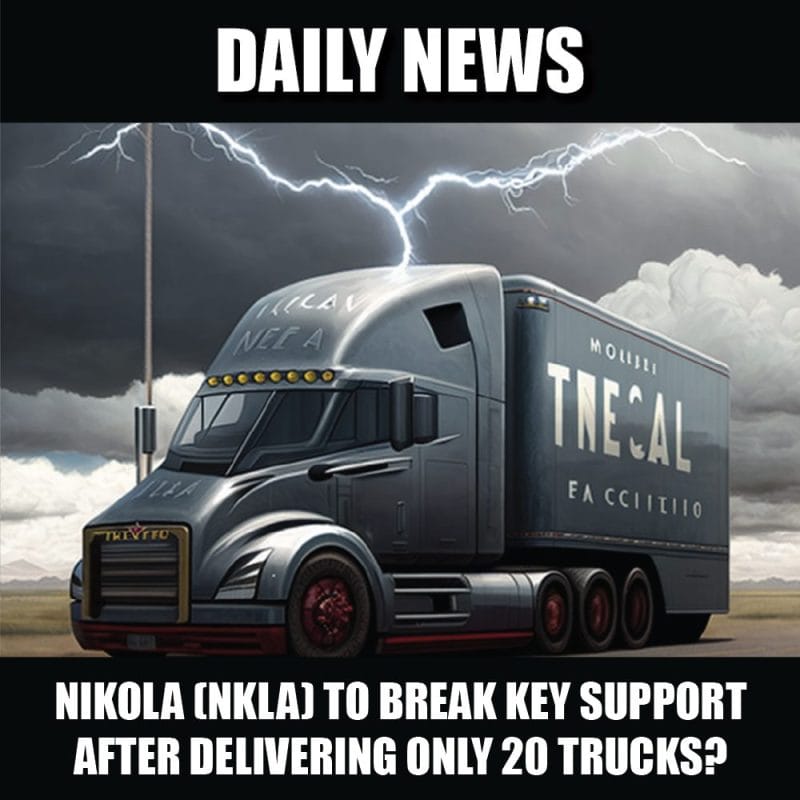It’s insanity on wheels in the EV sector as companies who deserve a stock price bump aren’t getting it while charlatans rake it in. A duplicitous air as thick as Eric Trump surrounds the space, making it difficult to pick the wheat from the chaff. Power constraints in China, phantom EV operators and a slowing global economy spell out change for an industry badly in need of correction, but reality has yet to touch this surreal market wonderland. It’s time to get past the painted roses in this next EV sector roundup.
 Arcimoto’s (FUV.Q) Q2 was over-shadowed by supply chain issues but its balance sheet according to executives was the strongest in the company’s 14-year history. Also in the quarter, Arcimoto applied to the Department of Energy for a loan that would cover most of its near-term growth. As a result, management opened a dialogue with the DoE and hopes to refine and submit a 2nd draft application soon. On top of two company rental stores in Eugene, Oregon and San Diego, California, Arcimoto intends to expand its market footprint by delivering rental units to Go Car Tours in San Diego and San Francisco. With sales and rentals in Oregon, Washington, and Florida, the EV manufacturer looks to penetrate the Hawaii, Arizona, and Nevada EV markets. Arcimoto is in negotiations with a Californian municipality to supply EVs for the city’s lifeguards. The company’s philosophy of right-sizing transportation is a radical but necessary departure from the 50s philosophy of living large. However, that presents the not so small challenge of convincing drivers without handle-bar moustaches and over-sized beanies to leave their SUV behind. There isn’t a lot of hot air in Acrimoto’s mandate, but like 3D printing, its value proposition is based on a significant cultural change. Unfortunately for the EV manufacturer, short sellers control 32.9% of the float as of August 31, 2021. This produces a tremendous pressure for Arcimoto to perform sooner than later. On Tuesday, the company trades at $11.47 per share, 1.21% lower than last week for a market cap of $428.89 million. Do as you will on this one.
Arcimoto’s (FUV.Q) Q2 was over-shadowed by supply chain issues but its balance sheet according to executives was the strongest in the company’s 14-year history. Also in the quarter, Arcimoto applied to the Department of Energy for a loan that would cover most of its near-term growth. As a result, management opened a dialogue with the DoE and hopes to refine and submit a 2nd draft application soon. On top of two company rental stores in Eugene, Oregon and San Diego, California, Arcimoto intends to expand its market footprint by delivering rental units to Go Car Tours in San Diego and San Francisco. With sales and rentals in Oregon, Washington, and Florida, the EV manufacturer looks to penetrate the Hawaii, Arizona, and Nevada EV markets. Arcimoto is in negotiations with a Californian municipality to supply EVs for the city’s lifeguards. The company’s philosophy of right-sizing transportation is a radical but necessary departure from the 50s philosophy of living large. However, that presents the not so small challenge of convincing drivers without handle-bar moustaches and over-sized beanies to leave their SUV behind. There isn’t a lot of hot air in Acrimoto’s mandate, but like 3D printing, its value proposition is based on a significant cultural change. Unfortunately for the EV manufacturer, short sellers control 32.9% of the float as of August 31, 2021. This produces a tremendous pressure for Arcimoto to perform sooner than later. On Tuesday, the company trades at $11.47 per share, 1.21% lower than last week for a market cap of $428.89 million. Do as you will on this one.
 Canoo (GOEV.Q) also struggles with a 32.94% short interest as WallStreetBets attempts to rally around the stock, but group members have questioned WSB’s motives, becoming wise to the Reddit group’s pump and dump approach to short squeezes. Has the novelty and perceived pure intent of WSB’s calls-to-action worn off? We’ll just have to see. That said, I like the EV manufacturer’s skateboard platform design and revenue stream potential, but it must lose its split personality, drop the lifestyle branding and focus on business fleet sales. Regardless of my opinion, the EV manufacturer intends to bring its Gamma Lifestyle Vehicle to market in the fourth quarter of 2022 with the company’s Oklahoma-based mega microfactory expected to open its doors in 2023. This is a tall order to bring promise to performance, but I am rooting for them to do it. On Wednesday, Canoo traded at $7.43 per share for a market cap of $1.82 billion.
Canoo (GOEV.Q) also struggles with a 32.94% short interest as WallStreetBets attempts to rally around the stock, but group members have questioned WSB’s motives, becoming wise to the Reddit group’s pump and dump approach to short squeezes. Has the novelty and perceived pure intent of WSB’s calls-to-action worn off? We’ll just have to see. That said, I like the EV manufacturer’s skateboard platform design and revenue stream potential, but it must lose its split personality, drop the lifestyle branding and focus on business fleet sales. Regardless of my opinion, the EV manufacturer intends to bring its Gamma Lifestyle Vehicle to market in the fourth quarter of 2022 with the company’s Oklahoma-based mega microfactory expected to open its doors in 2023. This is a tall order to bring promise to performance, but I am rooting for them to do it. On Wednesday, Canoo traded at $7.43 per share for a market cap of $1.82 billion.
 ElectraMeccanica (SOLO.Q) pulled into gear in the last week but ran out of gas, slipping from $3.94 per share on September 27th to $3.58 on Wednesday. Much of the climb was associated to building hype of the EV manufacturer commencing the delivery of its flagship SOLO EVs on October 4th. The company announced on Tuesday that it had received honorable mention in Fast Company’s Innovation by Design Awards for 2021 in the General Excellence and Mobility categories. Like Arcimoto, EM is another proponent of right-sizing personal transportation. Its three-wheeled all-electric SOLO has a range of 100 miles and a top speed of 80 mph, making it a potential contender for both the single person urban commute as well as someone zipping between the city and a nearby bedroom community. Only one thing to say about its compact architecture though, like the recumbent bicycle, SOLO drivers operate below the typical driver’s line of sight, which may increase the risk of highway travel. Besides forcing SOLO drivers to adopt the cyclist’s credo of “everybody else on the road is out to kill me”, EM’s mandate and product align with our future transportation needs more than most manufacturers in the EV space. The company had a market cap of $414.86 million on Wednesday.
ElectraMeccanica (SOLO.Q) pulled into gear in the last week but ran out of gas, slipping from $3.94 per share on September 27th to $3.58 on Wednesday. Much of the climb was associated to building hype of the EV manufacturer commencing the delivery of its flagship SOLO EVs on October 4th. The company announced on Tuesday that it had received honorable mention in Fast Company’s Innovation by Design Awards for 2021 in the General Excellence and Mobility categories. Like Arcimoto, EM is another proponent of right-sizing personal transportation. Its three-wheeled all-electric SOLO has a range of 100 miles and a top speed of 80 mph, making it a potential contender for both the single person urban commute as well as someone zipping between the city and a nearby bedroom community. Only one thing to say about its compact architecture though, like the recumbent bicycle, SOLO drivers operate below the typical driver’s line of sight, which may increase the risk of highway travel. Besides forcing SOLO drivers to adopt the cyclist’s credo of “everybody else on the road is out to kill me”, EM’s mandate and product align with our future transportation needs more than most manufacturers in the EV space. The company had a market cap of $414.86 million on Wednesday.
 Fisker (FSR) swims in short interest with 30.21% of its float shorted. It’s not hard to see why. The EV manufacturer has promised big production numbers by 2025 but has yet to produce anything but promises. Yes, chip shortages, global economic downturns and market saturation heavily impact the EV space, but Fisker’s lack of performance shouldn’t be swept under the rug of an industry-wide investment malaise. The EV manufacturer has much to live up in the next two years and there are no guarantees it will justify its initial hype. At a market cap of $4.35 billion as of Wednesday, Fisker probably won’t see much positive share price action until the production launch of its flagship Ocean SUV in late 2022. However, with Foxconn tentatively buying manufacturing real estate in Ohio, its project PEAR just may turn things around for the company, making it a solid player in the EV space. Do your due diligence! Fisker traded at $14.69 per share on Wednesday, up 3.82% over the preceding five days.
Fisker (FSR) swims in short interest with 30.21% of its float shorted. It’s not hard to see why. The EV manufacturer has promised big production numbers by 2025 but has yet to produce anything but promises. Yes, chip shortages, global economic downturns and market saturation heavily impact the EV space, but Fisker’s lack of performance shouldn’t be swept under the rug of an industry-wide investment malaise. The EV manufacturer has much to live up in the next two years and there are no guarantees it will justify its initial hype. At a market cap of $4.35 billion as of Wednesday, Fisker probably won’t see much positive share price action until the production launch of its flagship Ocean SUV in late 2022. However, with Foxconn tentatively buying manufacturing real estate in Ohio, its project PEAR just may turn things around for the company, making it a solid player in the EV space. Do your due diligence! Fisker traded at $14.69 per share on Wednesday, up 3.82% over the preceding five days.
![]() Green Motor Power Company (GPV.V) pulled in gross profits of $850,632 CAD in Q1 2022 equaling 32% of revenues. Unfortunately, hard costs, growth expenses, depreciation and share compensation of $743,513 resulted in a quarterly loss of $2,261,623 or $0.11 per share. With revenues of $2,659,002 for Q1, GMPC has a lot to chip away at before it sees a positive bottom line. The company does have assets though as its inventory, property and equipment totals $20,022,420 as of June 30, 2021. With no draw on its $8 million credit line, cash balance of just over $9 million and working capital of $31,391,694, the EV manufacturer has some room to breathe as it signs more partnerships like the deal with Forest River, a Berkshire Hathaway company, with annual sales exceeding $5 billion. Forest River delivers approximately 9,000 Starcraft cutaway buses a year and controls a 70% share of the cutaway bus market. The agreement to place GMPC’s EV Star CC in Forest’s line up as an electrification option could result in a noticeable long-term sales increase for GMPC. The company finished Q1 with a total of 21 deliveries and already has 12 unit sales, including the first delivery of its BEAST EV school bus, under its belt. Even though there are no guarantees, GMPC runs a tight financial ship and has less risk than many of its counterparts. I like this company; you should check it out. Don’t forget your research though! GMPC traded at $14.74 per share on Thursday, up 3.44% from the preceding five days, for a market cap of $415.41 million.
Green Motor Power Company (GPV.V) pulled in gross profits of $850,632 CAD in Q1 2022 equaling 32% of revenues. Unfortunately, hard costs, growth expenses, depreciation and share compensation of $743,513 resulted in a quarterly loss of $2,261,623 or $0.11 per share. With revenues of $2,659,002 for Q1, GMPC has a lot to chip away at before it sees a positive bottom line. The company does have assets though as its inventory, property and equipment totals $20,022,420 as of June 30, 2021. With no draw on its $8 million credit line, cash balance of just over $9 million and working capital of $31,391,694, the EV manufacturer has some room to breathe as it signs more partnerships like the deal with Forest River, a Berkshire Hathaway company, with annual sales exceeding $5 billion. Forest River delivers approximately 9,000 Starcraft cutaway buses a year and controls a 70% share of the cutaway bus market. The agreement to place GMPC’s EV Star CC in Forest’s line up as an electrification option could result in a noticeable long-term sales increase for GMPC. The company finished Q1 with a total of 21 deliveries and already has 12 unit sales, including the first delivery of its BEAST EV school bus, under its belt. Even though there are no guarantees, GMPC runs a tight financial ship and has less risk than many of its counterparts. I like this company; you should check it out. Don’t forget your research though! GMPC traded at $14.74 per share on Thursday, up 3.44% from the preceding five days, for a market cap of $415.41 million.
 Kandi Technologies (KNDI.Q) hasn’t released any news since announcing it had received its final payment for the Fengsheng sale over two weeks ago. That doesn’t mean nothing is happening that might impact the company. The troubles in China are mounting as the country comes to grips with the Evergrande fiasco, the collapse of its housing boom, the end of its EV boom, and growing power constraints due to coal supply shortages and the government’s refusal to let power companies to pass on the ‘savings’ to its citizens. The Belt and Road initiative was an effort to drag the mostly agrarian country into the 21st century as a global hegemonic power, but the alacrity with which the plan was enacted has left the republic reeling from change. Not that China won’t fulfill its upcoming role, replacing the U.S. as a world power, but economic and cultural growing pains are severely hampering Xi Jinping and the CCP’s mandate. Back to Kandi. I like the company because it’s focused on selling cars to you and me – not some snobby crypto-prick millionaire. Despite the challenges that surround this EV manufacturer, it has more promise than most. Do as you will. Kandi traded at $4.28 USD per share on Wednesday, down 5.20% over the preceding five days for a market cap of $324.89 million.
Kandi Technologies (KNDI.Q) hasn’t released any news since announcing it had received its final payment for the Fengsheng sale over two weeks ago. That doesn’t mean nothing is happening that might impact the company. The troubles in China are mounting as the country comes to grips with the Evergrande fiasco, the collapse of its housing boom, the end of its EV boom, and growing power constraints due to coal supply shortages and the government’s refusal to let power companies to pass on the ‘savings’ to its citizens. The Belt and Road initiative was an effort to drag the mostly agrarian country into the 21st century as a global hegemonic power, but the alacrity with which the plan was enacted has left the republic reeling from change. Not that China won’t fulfill its upcoming role, replacing the U.S. as a world power, but economic and cultural growing pains are severely hampering Xi Jinping and the CCP’s mandate. Back to Kandi. I like the company because it’s focused on selling cars to you and me – not some snobby crypto-prick millionaire. Despite the challenges that surround this EV manufacturer, it has more promise than most. Do as you will. Kandi traded at $4.28 USD per share on Wednesday, down 5.20% over the preceding five days for a market cap of $324.89 million.
 Li Auto (LI.Q) range extension technologies bridge the worlds of ICE and EV. It’s six-seat premium SUV, the Li One has been on the road since May. The EV manufacturer was founded by CEO Xiang Li. Mr. Li has been an internet entrepreneur for over 20 years, founding PCPop.com at the turn of the millennium and in 2005 establishing Autohome.com, which became a leading platform to purchase vehicles for both car dealers and consumers in China. Autohome did quite well, securing a 99% market share. Li used that cache and acquired business acumen to launch Li Auto in 2015, focusing the company’s efforts on the development of the Li One PHEV SUV. The SUV gathered considerable interest and by June 2020, the company had shipped approximately 10,400 units. Li Auto, like NIO and Xpeng, has to weather China’s current economic hardships, and probably won’t have any clear indication of market direction until the new year. On Thursday, Li Auto traded at $26.29 per share for a market cap of $27.96 billion.
Li Auto (LI.Q) range extension technologies bridge the worlds of ICE and EV. It’s six-seat premium SUV, the Li One has been on the road since May. The EV manufacturer was founded by CEO Xiang Li. Mr. Li has been an internet entrepreneur for over 20 years, founding PCPop.com at the turn of the millennium and in 2005 establishing Autohome.com, which became a leading platform to purchase vehicles for both car dealers and consumers in China. Autohome did quite well, securing a 99% market share. Li used that cache and acquired business acumen to launch Li Auto in 2015, focusing the company’s efforts on the development of the Li One PHEV SUV. The SUV gathered considerable interest and by June 2020, the company had shipped approximately 10,400 units. Li Auto, like NIO and Xpeng, has to weather China’s current economic hardships, and probably won’t have any clear indication of market direction until the new year. On Thursday, Li Auto traded at $26.29 per share for a market cap of $27.96 billion.
 Lordstown Motors’ (RIDE.Q) pulled its proverbial butt out of the fire when the company announced on Thursday it had cut a deal with Foxconn, a multinational contract electronics manufacturer best known as one of Apple’s oldest and largest suppliers. The non-binding agreement includes the sale of Lordstown’s 6.2 million square foot facility in Ohio that it had purchased from GM in 2019 for $20 million using a $40 million dollar loan from GM. Lordstown made some bank on the deal as Foxconn has not only tentatively agreed to shell out $230 million for the facility, but also agreed to throw in for $50 million of Lordstown common stock. Furthermore, both companies will negotiate a manufacturing contract that will see the international electronics juggernaut take over the assembly of Lordstown’s Endurance EV pickup with potential of future manufacturing agreements on Lordstown’s upcoming EV designs. All this happiness hinges on closing the purchase of the Ohio facility. This deal throws Lordstown a necessary lifeline and provides a North American EV manufacturing footprint for Foxconn who already has a deal with Fisker, signed in May, to co-develop and manufacture Fisker’s hush-hush project PEAR. This is a tantalizing tidbit of news for investors and the market showed its appreciation, sending Lordstown shares up 8.95% to $7.98 per share by end of trading Thursday for a market cap of $1.3 billion.
Lordstown Motors’ (RIDE.Q) pulled its proverbial butt out of the fire when the company announced on Thursday it had cut a deal with Foxconn, a multinational contract electronics manufacturer best known as one of Apple’s oldest and largest suppliers. The non-binding agreement includes the sale of Lordstown’s 6.2 million square foot facility in Ohio that it had purchased from GM in 2019 for $20 million using a $40 million dollar loan from GM. Lordstown made some bank on the deal as Foxconn has not only tentatively agreed to shell out $230 million for the facility, but also agreed to throw in for $50 million of Lordstown common stock. Furthermore, both companies will negotiate a manufacturing contract that will see the international electronics juggernaut take over the assembly of Lordstown’s Endurance EV pickup with potential of future manufacturing agreements on Lordstown’s upcoming EV designs. All this happiness hinges on closing the purchase of the Ohio facility. This deal throws Lordstown a necessary lifeline and provides a North American EV manufacturing footprint for Foxconn who already has a deal with Fisker, signed in May, to co-develop and manufacture Fisker’s hush-hush project PEAR. This is a tantalizing tidbit of news for investors and the market showed its appreciation, sending Lordstown shares up 8.95% to $7.98 per share by end of trading Thursday for a market cap of $1.3 billion.
 Lucid Group (LCID.Q) began production on its flagship Lucid Air model line, showing off the company’s Arizona manufacturing facility to the press on Tuesday. With 13,000-plus reservations for its Air sedan, the EV producer intends to commence deliveries in late October. Lucid has also slated the production of 520 Air Dream Edition models to celebrate its technological win over Tesla. Each special edition is expected to retail for $169,000 while the regular sedans are priced moderately at approximately $74,000 per. Lucid is expected to notch up production by delivering its Grand Touring, Touring and Air Pure models after the initial rollout. Despite the good news, share price ranged for the week, inching up 0.67% over the preceding five days to $25.38 per share by end of trading Thursday for a market cap of $41.08 billion. With the company’s valuation more than doubling since its public market entry, there probably won’t be a lot of upward mobility in market value until Lucid establishes its production and sales next fiscal period. Still, stock is reasonably priced and could provide a good investment opportunity for those looking for a ground floor purchase of a potentially blue-chip opportunity. My opinion of course, do not forget to do your homework and get the advice of an investment professional.
Lucid Group (LCID.Q) began production on its flagship Lucid Air model line, showing off the company’s Arizona manufacturing facility to the press on Tuesday. With 13,000-plus reservations for its Air sedan, the EV producer intends to commence deliveries in late October. Lucid has also slated the production of 520 Air Dream Edition models to celebrate its technological win over Tesla. Each special edition is expected to retail for $169,000 while the regular sedans are priced moderately at approximately $74,000 per. Lucid is expected to notch up production by delivering its Grand Touring, Touring and Air Pure models after the initial rollout. Despite the good news, share price ranged for the week, inching up 0.67% over the preceding five days to $25.38 per share by end of trading Thursday for a market cap of $41.08 billion. With the company’s valuation more than doubling since its public market entry, there probably won’t be a lot of upward mobility in market value until Lucid establishes its production and sales next fiscal period. Still, stock is reasonably priced and could provide a good investment opportunity for those looking for a ground floor purchase of a potentially blue-chip opportunity. My opinion of course, do not forget to do your homework and get the advice of an investment professional.
 Nikola (NKLA.Q) dropped off my radar after its initial scandal, but even after fraud charges being leveled at the EV manufacturer’s founder, Trevor Milton, at the end of July, it continues to limp on. Blaming chip shortages at the beginning of August, the company announced that saleable vehicles may not be available until 2022. The company intends to build long-haul semi trucks powered with either batteries or hydrogen fuel cells. Nikola had originally projected deliveries of 50 to 100 EV Nikola Tre Trucks in 2021 but guidance was pulled back to 25-50 vehicles for the year. Unfortunately, the company has yet to make a sale as of Q2 2021. It is still in validation phase on the first phase of five Nikola Tre BEVs. Even though all nine trucks from the second production batch have been built in the U.S., only three have reached validation stage. Nikola estimates that validation will continue through Q3 and into the beginning of Q4. The company celebrated the inauguration of its joint-venture manufacturing facility in Ulm, Germany back in the middle of the month and completed Phase 0.5 of its Coolidge, Arizona facility (whatever that means) during the last quarter. During Q2, it also entered into a purchase agreement with Tumim Stone Capital LLC for up to $300 million of Nikola common stock and acquired a 20% stake in the Wabash Valley Resources clean hydrogen project in West Terra Haute, Indiana. With 116 sales and service locations across the U.S. and an offtake agreement which could potentially provide 50 tons of clean hydrogen a day, Nikola has placed the proverbial cart before the horse. I am watching this outfit with a jaundiced eye as it seems to optimize what is wrong with the EV sector, however, like Lordstown, it may have a chance of pulling through. The company traded at $10.66 per share, down 5.14% from the preceding five days for a market cap of $4.29 billion. DO YOUR DUE DILIGENCE!
Nikola (NKLA.Q) dropped off my radar after its initial scandal, but even after fraud charges being leveled at the EV manufacturer’s founder, Trevor Milton, at the end of July, it continues to limp on. Blaming chip shortages at the beginning of August, the company announced that saleable vehicles may not be available until 2022. The company intends to build long-haul semi trucks powered with either batteries or hydrogen fuel cells. Nikola had originally projected deliveries of 50 to 100 EV Nikola Tre Trucks in 2021 but guidance was pulled back to 25-50 vehicles for the year. Unfortunately, the company has yet to make a sale as of Q2 2021. It is still in validation phase on the first phase of five Nikola Tre BEVs. Even though all nine trucks from the second production batch have been built in the U.S., only three have reached validation stage. Nikola estimates that validation will continue through Q3 and into the beginning of Q4. The company celebrated the inauguration of its joint-venture manufacturing facility in Ulm, Germany back in the middle of the month and completed Phase 0.5 of its Coolidge, Arizona facility (whatever that means) during the last quarter. During Q2, it also entered into a purchase agreement with Tumim Stone Capital LLC for up to $300 million of Nikola common stock and acquired a 20% stake in the Wabash Valley Resources clean hydrogen project in West Terra Haute, Indiana. With 116 sales and service locations across the U.S. and an offtake agreement which could potentially provide 50 tons of clean hydrogen a day, Nikola has placed the proverbial cart before the horse. I am watching this outfit with a jaundiced eye as it seems to optimize what is wrong with the EV sector, however, like Lordstown, it may have a chance of pulling through. The company traded at $10.66 per share, down 5.14% from the preceding five days for a market cap of $4.29 billion. DO YOUR DUE DILIGENCE!
 Nio’s (NIO) week on the boards looks like a bad heart palpitation but continues to range, trading at $35.63 per share. However, it announced today that it had increased it global vehicle deliveries in September by 125.7% year-over-year for a total of 10,628 units and for Q3, it showed a 100.2% increase year-over-year totaling 24,439 EVs. That makes a total of 142,036 deliveries of its ES8, ES6 and EC6 models as of September 30, 2021. The EV manufacturer also announced the opening of its NIO House and the completion of its first batch of vehicle deliveries in Norway. NIO still struggles with chip shortages and the economic situation in China isn’t getting any better as Evergrande continues to default, but it seems to be managing and may maintain its spot as a top manufacturer in EV space. Currently the company has a market cap of $57.56 billion and a total of 1.64 billion shares outstanding.
Nio’s (NIO) week on the boards looks like a bad heart palpitation but continues to range, trading at $35.63 per share. However, it announced today that it had increased it global vehicle deliveries in September by 125.7% year-over-year for a total of 10,628 units and for Q3, it showed a 100.2% increase year-over-year totaling 24,439 EVs. That makes a total of 142,036 deliveries of its ES8, ES6 and EC6 models as of September 30, 2021. The EV manufacturer also announced the opening of its NIO House and the completion of its first batch of vehicle deliveries in Norway. NIO still struggles with chip shortages and the economic situation in China isn’t getting any better as Evergrande continues to default, but it seems to be managing and may maintain its spot as a top manufacturer in EV space. Currently the company has a market cap of $57.56 billion and a total of 1.64 billion shares outstanding.
 Tesla’s (TSLA.Q) self-anointed ‘Technoking’ continues to ramble and lash out like a bad drunk after the company lost its fraud case in China and lost the support of one-time Tesla bull Chamath Palihapitiya who announced dropping his position in the EV manufacturer over the last year. Meanwhile Musk froths at the mouth dropping insults on Biden, Bezos, the SEC and whoever else dares to question his unbridled insanity. Now the company is alleged to be coaching its ‘FSD’ beta testers on what they can and cannot say on social media. What the hell are they afraid of? Reports of near misses or real representations of a falsely labeled, unsafe and dysfunctional product? Elon shaking his rattle petulantly at the Code Conference because his company wasn’t invited to the White House EV summit, is the height of puerile fury and his knocks against the SEC regulators are nothing more than criminal arrogance. I was a supporter of Tesla in the early days, but as Musk made his woeful lack of character and business ethic wildly apparent, I have grown into his worst critic. He has single-handedly poisoned the EV sector and space exploration while criminally abusing the public markets. I won’t rest until he is served his comeuppance. Yeah, not a Tesla investor. It’s your money, though, you can lose as much of it as you like.
Tesla’s (TSLA.Q) self-anointed ‘Technoking’ continues to ramble and lash out like a bad drunk after the company lost its fraud case in China and lost the support of one-time Tesla bull Chamath Palihapitiya who announced dropping his position in the EV manufacturer over the last year. Meanwhile Musk froths at the mouth dropping insults on Biden, Bezos, the SEC and whoever else dares to question his unbridled insanity. Now the company is alleged to be coaching its ‘FSD’ beta testers on what they can and cannot say on social media. What the hell are they afraid of? Reports of near misses or real representations of a falsely labeled, unsafe and dysfunctional product? Elon shaking his rattle petulantly at the Code Conference because his company wasn’t invited to the White House EV summit, is the height of puerile fury and his knocks against the SEC regulators are nothing more than criminal arrogance. I was a supporter of Tesla in the early days, but as Musk made his woeful lack of character and business ethic wildly apparent, I have grown into his worst critic. He has single-handedly poisoned the EV sector and space exploration while criminally abusing the public markets. I won’t rest until he is served his comeuppance. Yeah, not a Tesla investor. It’s your money, though, you can lose as much of it as you like.
 Workhorse Group (WKHS.Q) announced a senior management shakeup on Thursday, replacing departing CFO, Steve Schrader, with the company’s Corporate Controller, Greg Ackerson. Oddly, the company was quick to point out that Schrader’s departure had not based on any disagreement with the Workhorse’s accounting principles, practices, or financial statement disclosures. Huh? Anyway, changes didn’t stop there. The drone-integrated EV manufacturer brought on Jim Harrington, former SVP, general counsel, secretary and chief compliance officer at Delphi Technologies, to perform the duties of chief https://e4njohordzs.exactdn.com/wp-content/uploads/2021/10/tnw8sVO3j-2.pngistrative officer, general counsel and secretary for Workhorse. Also, Josh Anderson, founder and president of Leiten, came on board as chief technology officer, Jim Peters took on the role of VP, Purchasing and Supply Chain, Dave Bjerke accepted the responsibility of VP, Product Development and finally Rob Willison, chief operating officer, exited, taking the position with him as the company eliminated the role. Company CEO, Rick Dauch, explained the shuffle as an effort to aide Workhorse’s transition from EV start-up to a manufacturing entity. Considering all the grief the company has experienced recently including the recall of its flagship C-1000 and SEC investigation, something had to be done. Will this dose of new blood do it? Won’t know for sure until their office chairs have been suitably worn in. Probably leave this one alone for six months. Workhorse traded at $7.65 per share on Thursday for a market cap of $959.36 million.
Workhorse Group (WKHS.Q) announced a senior management shakeup on Thursday, replacing departing CFO, Steve Schrader, with the company’s Corporate Controller, Greg Ackerson. Oddly, the company was quick to point out that Schrader’s departure had not based on any disagreement with the Workhorse’s accounting principles, practices, or financial statement disclosures. Huh? Anyway, changes didn’t stop there. The drone-integrated EV manufacturer brought on Jim Harrington, former SVP, general counsel, secretary and chief compliance officer at Delphi Technologies, to perform the duties of chief https://e4njohordzs.exactdn.com/wp-content/uploads/2021/10/tnw8sVO3j-2.pngistrative officer, general counsel and secretary for Workhorse. Also, Josh Anderson, founder and president of Leiten, came on board as chief technology officer, Jim Peters took on the role of VP, Purchasing and Supply Chain, Dave Bjerke accepted the responsibility of VP, Product Development and finally Rob Willison, chief operating officer, exited, taking the position with him as the company eliminated the role. Company CEO, Rick Dauch, explained the shuffle as an effort to aide Workhorse’s transition from EV start-up to a manufacturing entity. Considering all the grief the company has experienced recently including the recall of its flagship C-1000 and SEC investigation, something had to be done. Will this dose of new blood do it? Won’t know for sure until their office chairs have been suitably worn in. Probably leave this one alone for six months. Workhorse traded at $7.65 per share on Thursday for a market cap of $959.36 million.
![]() XL Fleet Corp (XL) has been quiet this week and shares lost 3.3% over the preceding five days to trade at $6.16 per share for a market cap of $833.41 million on Thursday. Not much has changed, the company could be facing some class action suits regarding its SPAC entry which may have some material impact on the EV manufacturer. That said, I like the EV upgrade mandate and how it sidesteps the challenges of full-fledged manufacturing. The company’s deal with Stellantis has promise. Let’s see if there are any more announcements besides legal challenges.
XL Fleet Corp (XL) has been quiet this week and shares lost 3.3% over the preceding five days to trade at $6.16 per share for a market cap of $833.41 million on Thursday. Not much has changed, the company could be facing some class action suits regarding its SPAC entry which may have some material impact on the EV manufacturer. That said, I like the EV upgrade mandate and how it sidesteps the challenges of full-fledged manufacturing. The company’s deal with Stellantis has promise. Let’s see if there are any more announcements besides legal challenges.
 Xpeng (XPEV) had a similar quarter to NIO, announcing it had a record month in September with the delivery of 10,412 vehicles, a 199% increase year-over-year. The company’s Q3 2021 rang in the delivery of 25,666 vehicles, making a record quarter and a 199% increase over the same reporting period last year. With 56,404 total vehicles delivered year-to-date, the company celebrated a 301% increase year-over-year. However, like NIO, Xpeng is saddled with chip shortage concerns and the ballooning Evergrande fiasco which may dampen China’s economy and appetite for EV offerings. That said, Xpeng offers a superior product, dare I say to even Tesla, as you can be assured Xpeng’s products were assembled with care and pride, rather than panic. The new year will reveal the extent of China’s economic woes and just how deep the chip shortages will run, so it might be advantageous to take a seat and watch how things unfold in the meantime. Xpeng traded at $35.54 per share edging down 1.14% from the preceding five-day mark for a total valuation of $29.57 billion.
Xpeng (XPEV) had a similar quarter to NIO, announcing it had a record month in September with the delivery of 10,412 vehicles, a 199% increase year-over-year. The company’s Q3 2021 rang in the delivery of 25,666 vehicles, making a record quarter and a 199% increase over the same reporting period last year. With 56,404 total vehicles delivered year-to-date, the company celebrated a 301% increase year-over-year. However, like NIO, Xpeng is saddled with chip shortage concerns and the ballooning Evergrande fiasco which may dampen China’s economy and appetite for EV offerings. That said, Xpeng offers a superior product, dare I say to even Tesla, as you can be assured Xpeng’s products were assembled with care and pride, rather than panic. The new year will reveal the extent of China’s economic woes and just how deep the chip shortages will run, so it might be advantageous to take a seat and watch how things unfold in the meantime. Xpeng traded at $35.54 per share edging down 1.14% from the preceding five-day mark for a total valuation of $29.57 billion.
Now back to the traditional auto makers:
 GM (GM) announced on Tuesday that its commercial EV segment, BrightDrop, planned to add a second van to its lineup in 2023, noting Verizon Communications was scheduled to be the first customer to drive the new midsize work van off the lot. No details of the Verizon deal are available. BrightDrop is on schedule to deliver its EV600 model to FedEx by the end of the year. With the previously mentioned EV410 providing a smaller option to the EV600 while still maintaining an estimated range of 250 miles per full charge, company hopes to strengthen its hold on the commercial EV market. GM is currently partnered with German auto manufacturer Kuka in the initial production of FedEx’s EV600s, but it plans to retool a manufacturing facility in Ontario, Canada to produce both the EV600 and its upcoming smaller counterpart. Production of the EV600 at its Canadian facility is expected to commence in November 2022.
GM (GM) announced on Tuesday that its commercial EV segment, BrightDrop, planned to add a second van to its lineup in 2023, noting Verizon Communications was scheduled to be the first customer to drive the new midsize work van off the lot. No details of the Verizon deal are available. BrightDrop is on schedule to deliver its EV600 model to FedEx by the end of the year. With the previously mentioned EV410 providing a smaller option to the EV600 while still maintaining an estimated range of 250 miles per full charge, company hopes to strengthen its hold on the commercial EV market. GM is currently partnered with German auto manufacturer Kuka in the initial production of FedEx’s EV600s, but it plans to retool a manufacturing facility in Ontario, Canada to produce both the EV600 and its upcoming smaller counterpart. Production of the EV600 at its Canadian facility is expected to commence in November 2022.
![]() Ford (F) announced it would pour $11 billion into two new factories in the Southeast to produce batteries and up to a million electric pickup trucks per year. The auto manufacturing giant intends to construct its monster facilities in Stanton, Tennessee and Glendale, Kentucky. The $7 billion dollars Ford is dropping to build two mega battery plants in Glendale with its Korean partner, SK Innovation, is the largest single investment in the company’s history. The Tennessee factory, also known as the Blue Oval, is estimated to open its doors in 2025 with three main components, a pickup manufacturing facility, a monster battery plant built in conjunction with SK Innovation and a supplier park. Ford looks to be entering the EV race in a big way, bringing everything in house and on domestic ground. This is going to make things very interesting.
Ford (F) announced it would pour $11 billion into two new factories in the Southeast to produce batteries and up to a million electric pickup trucks per year. The auto manufacturing giant intends to construct its monster facilities in Stanton, Tennessee and Glendale, Kentucky. The $7 billion dollars Ford is dropping to build two mega battery plants in Glendale with its Korean partner, SK Innovation, is the largest single investment in the company’s history. The Tennessee factory, also known as the Blue Oval, is estimated to open its doors in 2025 with three main components, a pickup manufacturing facility, a monster battery plant built in conjunction with SK Innovation and a supplier park. Ford looks to be entering the EV race in a big way, bringing everything in house and on domestic ground. This is going to make things very interesting.
 Toyota continues to motor on despite the threat of boycotts. Don’t understand the public’s reaction, as the Japanese auto manufacturer pledged at the beginning of September to spend $13.5 billion to develop new low-cost battery tech by 2030, so it seems that Toyota’s supposed stalling is due to the Biden Administrations union-only EV cash incentives and not a general quashing of the EV industry. Tempest in a teapot.
Toyota continues to motor on despite the threat of boycotts. Don’t understand the public’s reaction, as the Japanese auto manufacturer pledged at the beginning of September to spend $13.5 billion to develop new low-cost battery tech by 2030, so it seems that Toyota’s supposed stalling is due to the Biden Administrations union-only EV cash incentives and not a general quashing of the EV industry. Tempest in a teapot.
 Volkswagen’s 2021 ID.4 earned the distinction of Top Safety Pick+ from the Insurance Institute for Highway Safety. This honor is the highest rating the non-profit safety agency gives out and according to a Green Car Reports article, that rating holds for the entire 2021 ID.4 lineup. I would like to add that Tesla will never receive any such honor unless it dumps its ‘FSD’ and its lunatic barker CEO.
Volkswagen’s 2021 ID.4 earned the distinction of Top Safety Pick+ from the Insurance Institute for Highway Safety. This honor is the highest rating the non-profit safety agency gives out and according to a Green Car Reports article, that rating holds for the entire 2021 ID.4 lineup. I would like to add that Tesla will never receive any such honor unless it dumps its ‘FSD’ and its lunatic barker CEO.
![]() Nissan has nothing new to add to the conversation right now.
Nissan has nothing new to add to the conversation right now.
As I wrap up this edition of the EV roundup, I want to touch on a couple of things. The emergence of the EV industry has put on a light on the sustainability of lithium mining. Currently the main methods of lithium extraction involve salars and hard rock mining. Brine extraction in salars is cheap and effective, however it requires 500,000 gallons of water per ton of lithium extracted. This is a huge problem, most notably illustrated by Chile’s Salar de Atacama where mining has caused the region to lose 65% of its bound water, critically impacting local farmers and the surrounding population they provide agriculture and cattle for. So, if you are invested in the lithium mining space, put your money on hard-rock miners, you’ll be doing the planet and its people a favor while investing in green energy.
Also, hydrogen has been making a comeback as a renewable fuel as technology improves and extraction becomes more environmentally friendly. I’m still on the fence with hydrogen even though it is the best choice for air and sea transportation. The fact that companies are still opting to extract it from natural gas, leaves fracking on the table, and I am not comfortable about that. Oh well, nothing comes for free, perhaps I should get off my high horse. Well, it’s late and almost morning, so I should bid you a fond adieu. If there is anyone I have missed, let me know and I will try to include them next time. I will also delve deeper in hydrogen in the future so we can get a picture of what’s going on. Anyway, do your research, identify your picks, and make this a better world. Good luck to all!
–Gaalen Engen







